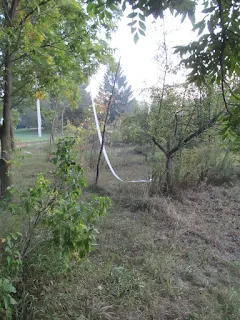One of the families makes a cache at the various destinations where they hunt and fish. Their rational is that it is inefficient to haul bulky objects on round trips. The room in the boat or sled is reserved for food or collected resources on the return trip.
My purpose would be slightly different. It would be either to supplement a "three day bag" or to replace one. A secondary purpose might be as a source of materials for a cold restart.
How long?
A foundational question is "How long might you leave the cache before using it?"
 |
| There are many neglected corners of property that are suitable for caches, even in populated urban areas. The risk is that the cache will be covered with pavement before you need it. This is a cache location that I scouted out but never used. |
Ten years makes many potential items non-starters. Vitamin pills...not a great choice. Most pharmaceuticals...non starter. Batteries...guess again.
Good choices include candles, water purification filters, canned fats, poncho, foam pad, cordage, knit hat and a change of socks, chap-stick, a small backpack a knife and wooden matches. Perhaps some maps, a compass, a small copy of the Bible, a copy of the U.S. Constitution and $20 in small bills. The poncho and candle can be combined for cold weather survival.
While leaving a firearm in a cache has a certain utility the risk and liability of losing such a pricey and litigious item is a problem. Ammo may be less of an issue. .22LR and 9mm don't take up much room and have much utility. 12 gauge with #6 shot has even more utility but is much bulkier.
The Genesis bomb
The Genesis bomb is the idea that you could do a cold restart, perhaps under a new identity in a location five hundred miles away.
As a person interested in gardening, it would also be a nice way to safeguard some of the seed-lines I have been a steward for. A house fire would wipe out the lines of maize and other species I have been working with.
Common references suggest that nearly all garden seeds peter out in three-to-five years. The outside limit for some species is ten years.
One of the assumptions buried in those guidelines is that the average gardener wants enough germination so that the seed, when planted at common seed densities, will canopy. For instance, it is common to plant green beans four inches apart within the row and thin to every eight or twelve inches. If 40% of the seed germinated then the row would still have the appropriate plant density.
What if you stored two hundred seeds and would be satisfied if those seeds produced five, viable plants to continue the line? Now you are looking at 2.5% seed germination. That might be a much, much longer time than for the 40% viability time.
The W.J. Beal experiment
In the fall of 1879, Professor William James Beal buried 20 bottles containing seeds with the intent to determine the length of time the seeds of some of our most common plants would remain dormant in the soil, yet germinate when exposed to favorable conditions.
The 15th bottle was unearthed in April 2000 by Drs. Frank W. Telewski and Jan Zeevaart, 120 years after the bottles were first buried by Professor Beal
After 10 days the first seeds had germinated and eventually the total number of plants reached twenty-five. All of the plants were in the genus Verbascum, twenty-three were positively identified as Verbascum blattaria (Moth Mullein). Two of the plants appear to have a slightly different foliage and will be positively identified after they bloom. Although twenty different species of seed were placed in the bottles, initially only Verbascum germinated during this most recent trial. However, after the sandy mix containing the original seeds was given a cold treatment in August, a single Malva neglecta (syn. Malva rotundifolia) germinated in September, bringing the total number of seedlings to twenty-six.What would you put in a cache?
Added later....List of some suggestions that came in via email:
- Bug dope
- Sun screen
- Prescription eyeglasses
- Magnifying glass for slivers and starting fires






















































